
























Ap elstaedt. Launched in 2011, the Ditto Project has provided a total of 7,784 silicone prostheses costing more than R5,9 million to women who could not a ord one.
“The Ditto Project aims to help women regain their self-con dence, giving them access to high-quality silicone breast pros theses and also assisting them – through local branches of R4R – to ensure they choose the correct shape and size for their body,” says Stephné Jacobs, Chairperson of R4R. “Having a mastectomy leads to a tier of decision making regarding whether to have surgical reconstruction, wear an external breast prosthesis, or not wear anything at all to replace the amputated breast,” says Stephanie van Deventer, National Manager of R4R.
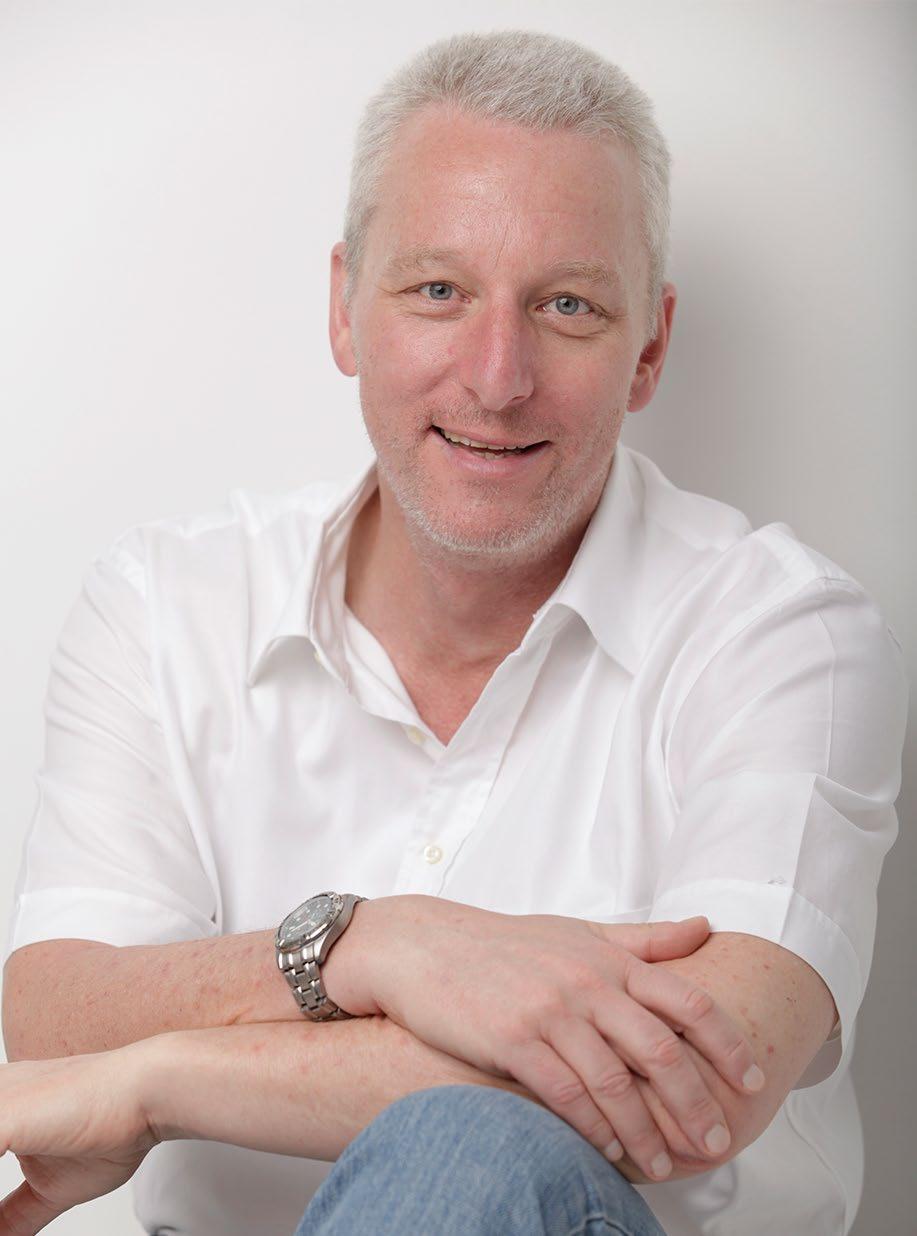
According to Dr Hoosain, “With a breast cancer diagnosis, there is the possible trauma of the diagnosis, the physiological side-e ects of the various treatments (hor mone uctuations, fatigue, nausea, pain), the dramatic changes to your body follow ing mastectomy as well as side e ects from radiation and chemotherapy treat ments such as weight gain or loss, for example. Some women struggle with a feeling of having ‘lost their wholeness’. All of this can lead to self-esteem issues, and in some cases, even depression. The work that The Ditto Project does is of immense value. Not only from an aesthetic view point, by providing a prosthesis, but from a psychological viewpoint; by providing a sense of wholeness to those who feel a physical loss.”

Carla Lind – Regional Chair for Reach for Recovery Western Cape and volunteer Michele Coe, spearheaded a further project via the Cape Peninsula branch of R4R. “State patients do not have the luxury of shopping at a mastectomy boutique for a proper mastectomy bra after they have received an external breast from the Ditto Project. Many of them do not have access to either the proper bra or the correct size, so vital for supporting the external pros thesis,” says Lind. “So, in May 2022, the Cape Peninsula branch of the Ditto Project also started o ering a new, subsidised mastectomy bra. This has been a develop ment project in collaboration with Thurs days Lingerie – to provide a locally made mastectomy bra at a price point that was accessible.”
Says Shona Macdonald, owner of Thurs days Lingerie: “Speaking to Reach for Recovery about the Ditto Project, and understanding their mission to help breast cancer survivors feel comfortable in their bodies post-surgery, really resonates with my initial reasons for launching Thursdays Lingerie. Designing a bra that can give these women a sense of self pride, allow ing them to recognise themselves in the mirror and feel beautiful in public spaces, is so meaningful. Our vocation is to help women see themselves through the kind and loving eyes of their best friend.”
The design of a mastectomy bra is far more complex than that of regular underwear. An internal stretch mesh layer is added to a baseline design that acts as a thin pocket on both breasts. This allows the prosthesis to easily slide in and be kept rmly in place during wear. The pattern grading allows a t for both smaller and bigger sizes. The bra also features a wide under band (the band that goes under the cups and around the back) that helps the bra to stay in place. The straps on a mastectomy bra are also wider than those on a standard bra. This is more comfortable for most women, especially those who are overweight. For example, wearing a size 12 prosthesis can be very heavy. Thursdays used their sup portive Cape Everlasting Wireless Bralette pattern as a baseline for the mastectomy bra. After consultation with R4R, it was then developed into the Carla Mastecto my Bra launched this year.
Says Mercy Dzemunyasi, a recipient of both a R4R prosthesis and mastectomy bra who recently took part in a photoshoot to

help raise awareness for this initiative, “Reach for Recovery came at the right time. I was diagnosed at an early age, and it was really shocking, so I was feeling both depressed and shattered. When the pros thesis came along, it was a huge change for me. My self-con dence and self-es teem were at an all-time low and this made an enormous di erence. When I then got the mastectomy bra, it was an even more enormous di erence. I felt like a whole woman again. The little things make a huge di erence when you’re going through something like this. The Ditto Project is literally a lifesaver.”
Concludes Dr Ap elstaedt: “Reach for Recovery wants to help women who are dependent on public health services to feel con dent again after the traumatic diagnoses and surgery. We believe that a breast prosthesis is an important step in her recovery, especially for those women from communities where there is still a stigma attached to a cancer diagnoses. A more natural appearance with a breast prosthesis, together with the emotional support that she can continue to receive from Reach for Recovery volunteers through support groups, will help her to return to her normal life.”
In support of breast cancer month, Thurs days Lingerie is donating 5% of any purchase of the Carla Mastectomy Bra via their e-commerce site to the Cape Penin sula branch of Reach for Recovery. This month will also see Dr Ap elstaedt donate funds raised through any speaking events in support of the Ditto Project.
Eye Care Awareness Month is commemorat ed from 21 September to 18 October to raise awareness about the importance of eye health, speci cally around the prevention and treatment of avoidable blindness.
50% of blindness is estimated to be caused by cataract, a ecting an estimated 170,000 people in South Africa. Cataract is known as the clouding of the normally clear lens of the eye and forms when protein builds up in the lens of one’s eye and makes it cloudy. This keeps light from passing through clearly and can cause the a ected party to lose some of their eyesight, thus negatively a ecting their quality of life.
“We weren’t aware of just how prevalent the issue of blindness caused by cataract in our communities was, but once we had sight of the numbers, it became incredibly impor tant for us to get involved and help out,” said Glencore’s Community Development Specialist, Mapule Mokoena.
According to the South African National Council for the Blind (SANCB), the Nkangala district in Mpumalanga has a high preva lence of cataracts and very few eye care activities due to inadequate resources in the district. This means that close to 6000 people have avoidable blindness in these communi ties as caused by cataract.
This was the unfortunate case for self-em ployed Carpenter, Gideon Mola before he received the much needed surgery through Glencore’s support.
“My vision has always been misty to the point where I couldn’t even see properly at school. The last time I had my eyes tested was three years ago and my eyes had gotten much worse at that point. Life was getting more di cult as I couldn’t work productively and this was a ecting my ability to making a living. Now that I have had the surgery, I am con dent that my life will improve signi cantly. I’m excited to look at the world with fresh new eyes.” he said.
To better understand just how much support was needed, Glencore partnered with the SANCB to identify community members in need of the surgery. The two companies commenced a Witbank Hospital tour where more than 30 patients were screened and 22 underwent cataract surgery with the help of the hospital surgeons, Dr Mthethwa and Dr Sebogodi.
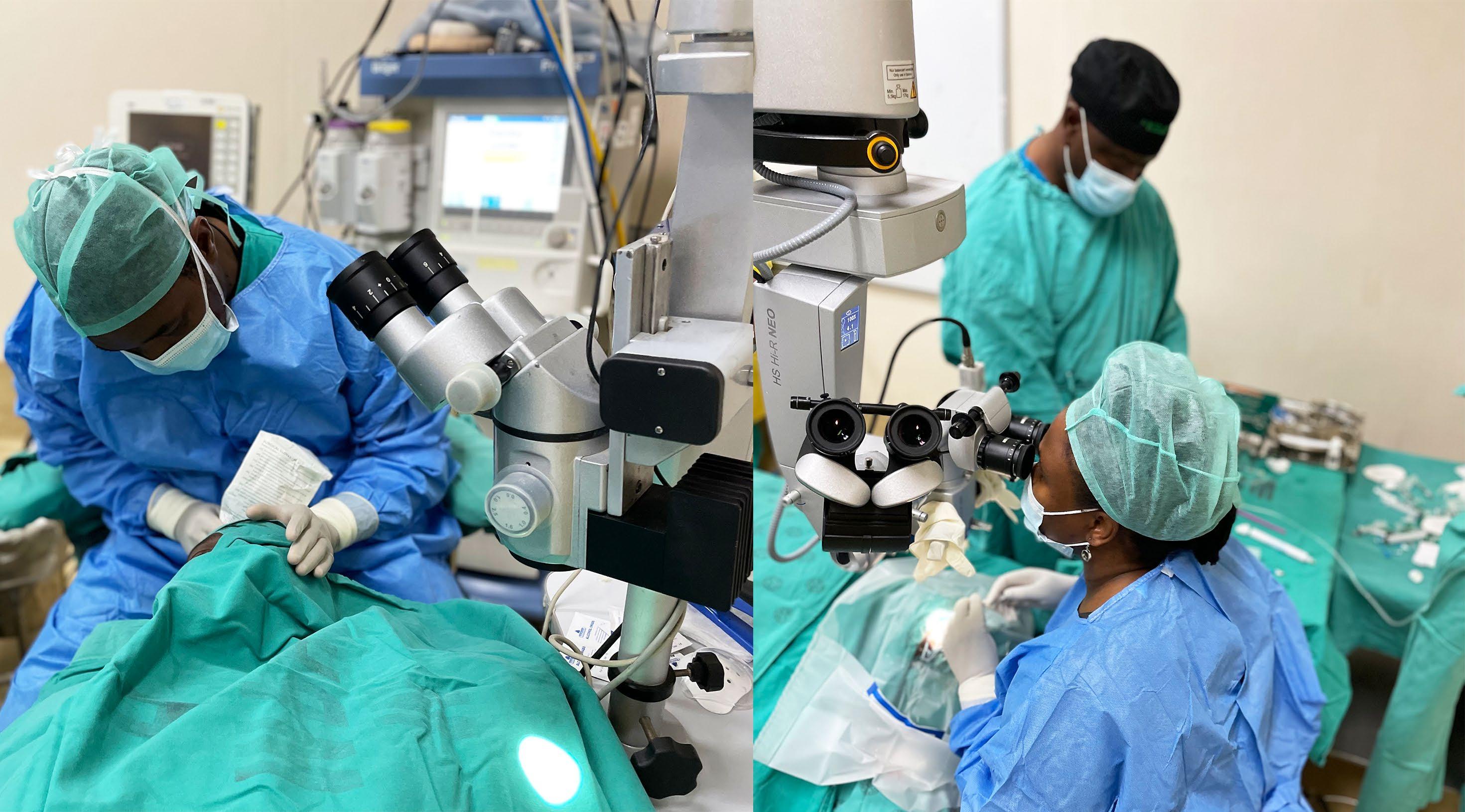
“What has been done through this incredi ble partnership has enabled us to slowly change the statistics of people needing cata ract operations in the district. This means providing direct eye care service to our com munity members who do not have access to eye care services. We are happy to have

played our part in reducing the prevalence of avoidable blindness in our communities.,” said Glencore’s Community Development Specialist, Mapule Mokoena.
Through the partnership, the mining opera tion aims to provide comprehensive eye care to community members as this is an essential part of the global action plan which is to meet the eye care needs of mar ginalized communities in the country.
“The success of such a project is based on the partnerships that the South African National Council for the Blind has, as no organisation can successfully implement the programme on its own. This is also why we partnered with Glencore Coal. When we rst approached Glencore, they were eager to jump on board based on their commitment to improving the lives of their communities. Their response gave us the encouragement we needed as we also want to improve peo ple’s quality of life” said SANCB Manager, Angelina Khupe.
You may su er from cataract if you note these signs and symptoms; clouded, blurred or dim vision, increasing di culty with vision at night, sensitivity to light and glare, need for brighter light for reading and other activities, seeing "halos" around lights to name but a few.
As hand hygiene and skin health become major priorities for individuals and families across South Africa, axseed oil has emerged as a healthy and e ective way to improve skin health.
Flaxseed oil has been found to enhance the skin’s own ability to clean itself, boosting natural antibiotic protection and providing prolonged protection against bacteria. It also has internal health bene ts – axseed oil contains omega-3, omega-9 fatty acids , and omega-6 fatty acids, which studies have found to have positive heart bene ts.
Flaxseed oil is also known to improve skin smoothness and hydration, to reduce in ammation, control sebum production,
and to prevent pollutants from entering the skin. As an ingredient in new Protex Flaxseed bar soap, axseed oil helps to protect against germs while penetrating the skin and boosting its ability to ght bacteria.
The new soap o ers South Africans revolu tionary health bene ts, incorporating this recognised bacteria-protection e ect using pure, cold-pressed axseed oil. It has been shown to boost the skin’s natural defences for up to 24 hours after use.

“We believe an ingredient is not protecting unless it makes you stronger,” said Panagiot is Tsourapas, group President, Colgate-Latin America, Asia Paci c & Africa-Eurasia. “This is why we have added axseed oil to our new
Protex bar soap. The new soap represents the biggest natural innovation in body care since the launch of Protex in 1985.”
Tsourapas said thanks to the protection that new Protex Flaxseed provides, people using it would now have greater con dence to get out and enjoy life.
“Protex Flaxseed gives you the con dence and freedom to reach out and touch everything good in the world,” he said. “New axseed technology protects against germs while also rejuvenating skin and making you healthier.
“By combining these health bene ts, Protex is looking to improve our attitude to life. It’s about going beyond regular soap, and rede ning what soap does for us.”
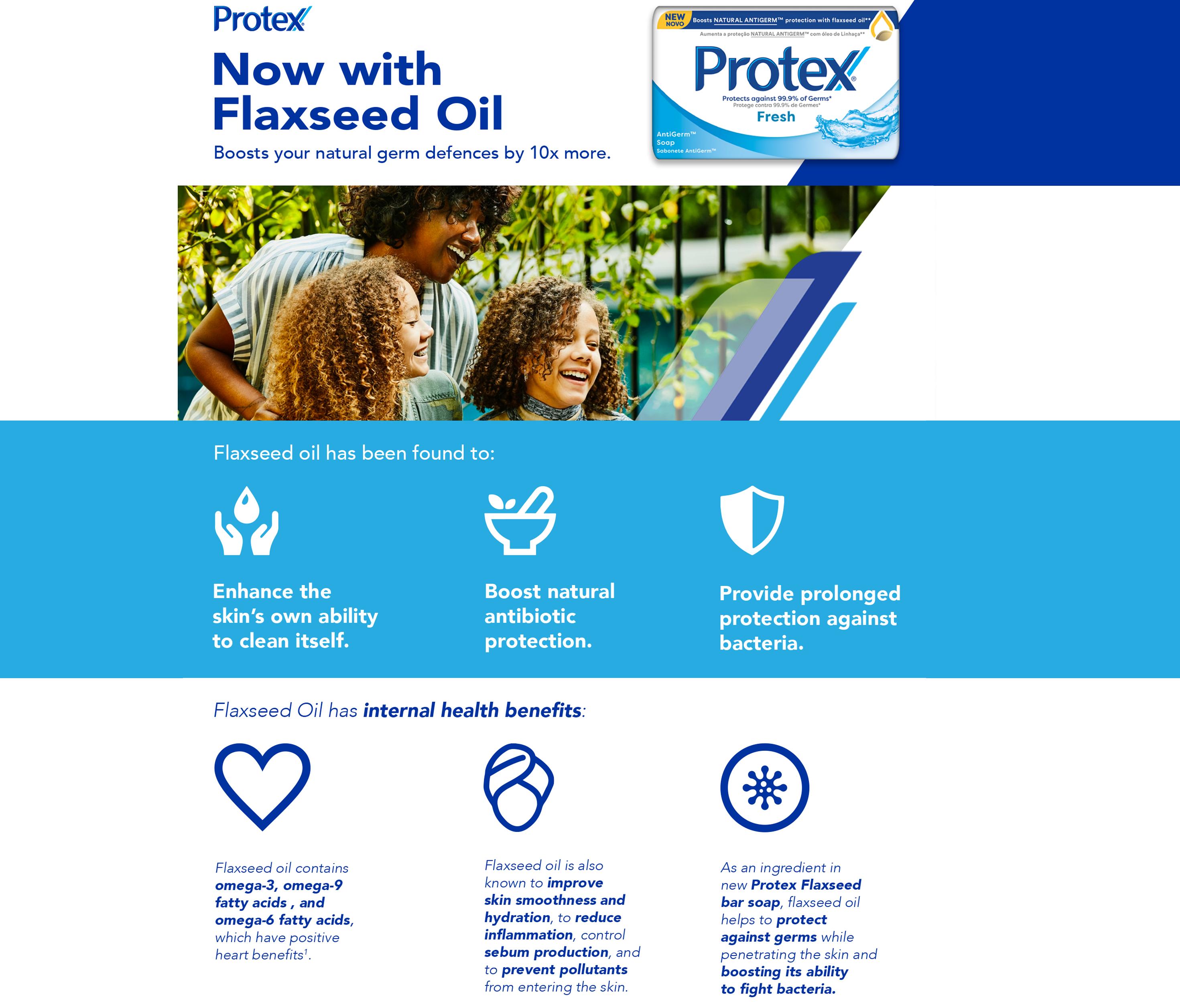
Depending on how it is used, social media has the power to either help build a person’s self-esteem or feed their insecurities. Octo ber is World Mental Health Month, and Netcare Akeso is challenging everyone to re ect on how they see themselves as a foundation for better mental wellbeing all year round.
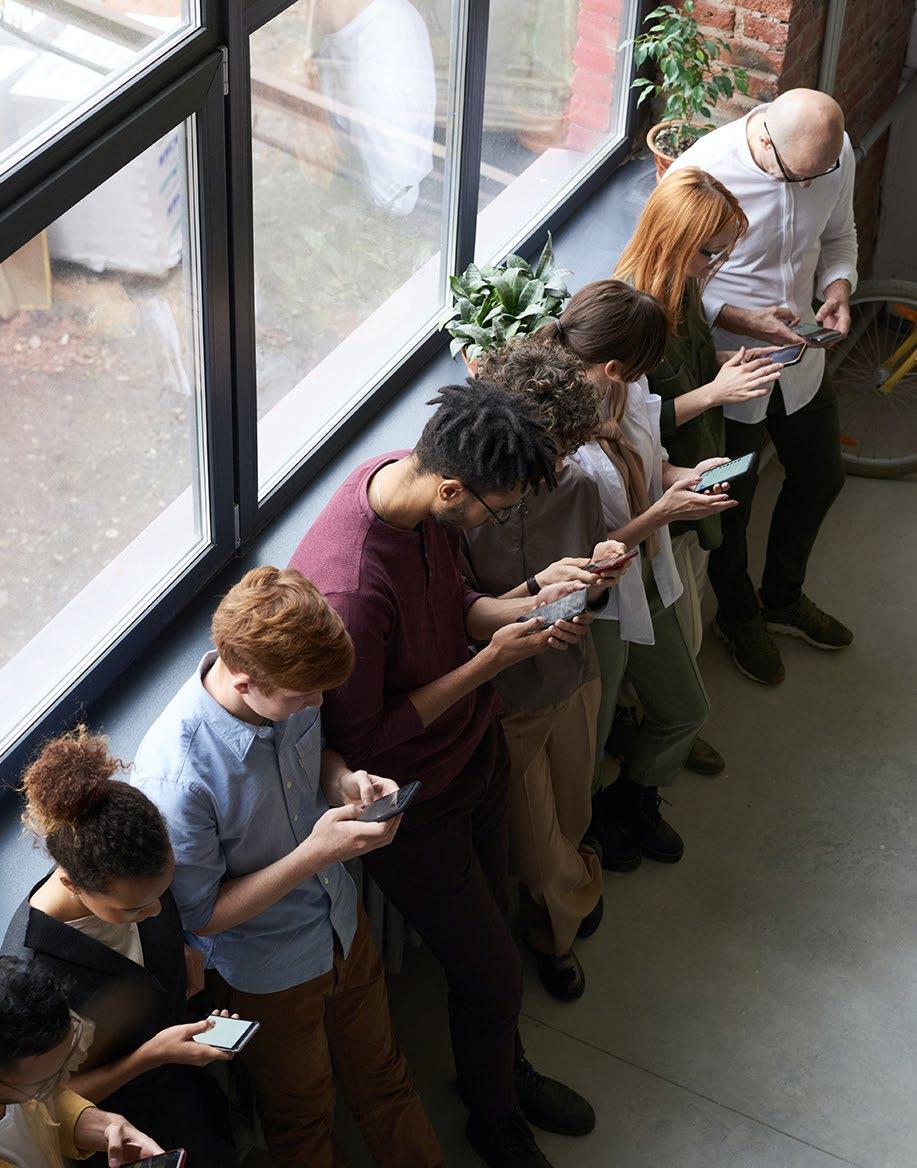
“Look beyond the image re ecting back at you, and realise that you are so much more. This is the rst step in maintaining positive mental health,” says Melanie Da Costa, man aging director of Netcare Akeso and Netcare Group director of strategy and health policy.
Megan Hosking, Netcare Akeso crisis line and marketing manager, adds that healthy self-esteem is nurtured when we learn to love the many di erent facets of ourselves beyond the surface level measures of physi cal appearance. “The preoccupation that many people have with sel es as a means of expressing their identity, particularly young er social media users, tends to highlight a person’s looks and the number of ‘likes’ they attract on these platforms as a measure of self-worth, which can be exceptionally destructive for one’s self esteem.
“Add to this the highly ltered, edited and posed images that proliferate on social media creating an expectation of unrealistic standards that young people often feel pres sure to live up to. The danger of ‘sel e culture’ is that it threatens to erode self-con dence by narrowing how we de ne and what we value about ourselves as people, which is fundamental to mental wellbeing,” Hosking says.
“This World Mental Health Month, we chal lenge you to focus on what aspects you love about yourself that are more than skin deep. Flip the narrative on sel e culture, and take this opportunity to think about your other abilities, attributes and good qualities.
“If you nd yourself preoccupied with social media or your self-image is dominated by how you look, take the time to break down the false perception of yourself and build up your self-con dence with this exercise.
Step 1: Take a no make-up, no lter photo of yourself when you don’t look your best.
Step 2: Don’t post it to social media. Instead, use it as a self-re ection tool and take a minute to consider how you look at your own image and to become aware of how you see yourself.
Step 3: List your strengths and capabilities, and that which you identify as being ‘you’.
Step 4: Be realistic about yourself and set daily goals towards improving any aspects that you may wish to develop. For example, if you nd you’ve been scrutinising yourself with a narrow focus on your appearance, reconsider which accounts you follow or think about taking a break from certain media or social media platforms.
Step 5: Love yourself for more than what can be seen in a mere sel e, including the contri butions you make to the world and other people’s lives.
“Instead of dedicating time and energy to the unattainable standards of sel e culture, which may encourage people to be overly critical of themselves, rather empower your self with a more compassionate view of yourself. Only you can de ne who you are as a person, and your true merit,” Hosking says.


Mental wellbeing is a continuous jour ney
“Maintaining good mental health requires us to consciously be aware of and check in with ourselves, constantly putting in the work to stay healthy and well. This entails forming constructive habits, having a solid support system and having conversations with the right people to ensure you have access to help, if needed,” Da Costa notes.
Family and true friends can o er invaluable emotional support, and professional assis tance is available through a number of chan nels, including Netcare Akeso mental health facilities on either an outpatient or inpatient basis.
“Building and maintaining a healthy self-es teem can be a daunting process – remember you are not alone.”
If you are having an emotionally di cult time, Netcare Akeso’s 24 hour crisis line is always here for you on 0861 435 787. Trained counsellors are available to listen without judgement, and can guide you on the various options for assistance, whether for yourself or for a loved one. The South African Anxiety and Depression Group (SADAG) also provides a 24 hour suicide crisis helpline on 0800 567 567.

October is Mental Health Awareness Month in South Africa, a month that aims to shine a light on and destigmatise the silent epidem ic that a ects millions of people.
Alon Lits, the co-CEO and co-founder of Panda, the mental health support app that launched a year ago, explains the signi cant role technology plays in providing access to those who need a ordable mental health support and resources. Until now, access to mental health support has been limited. It is expensive to see a therapist, and the stigma surrounding mental illness has stopped so many people from getting the help they need.
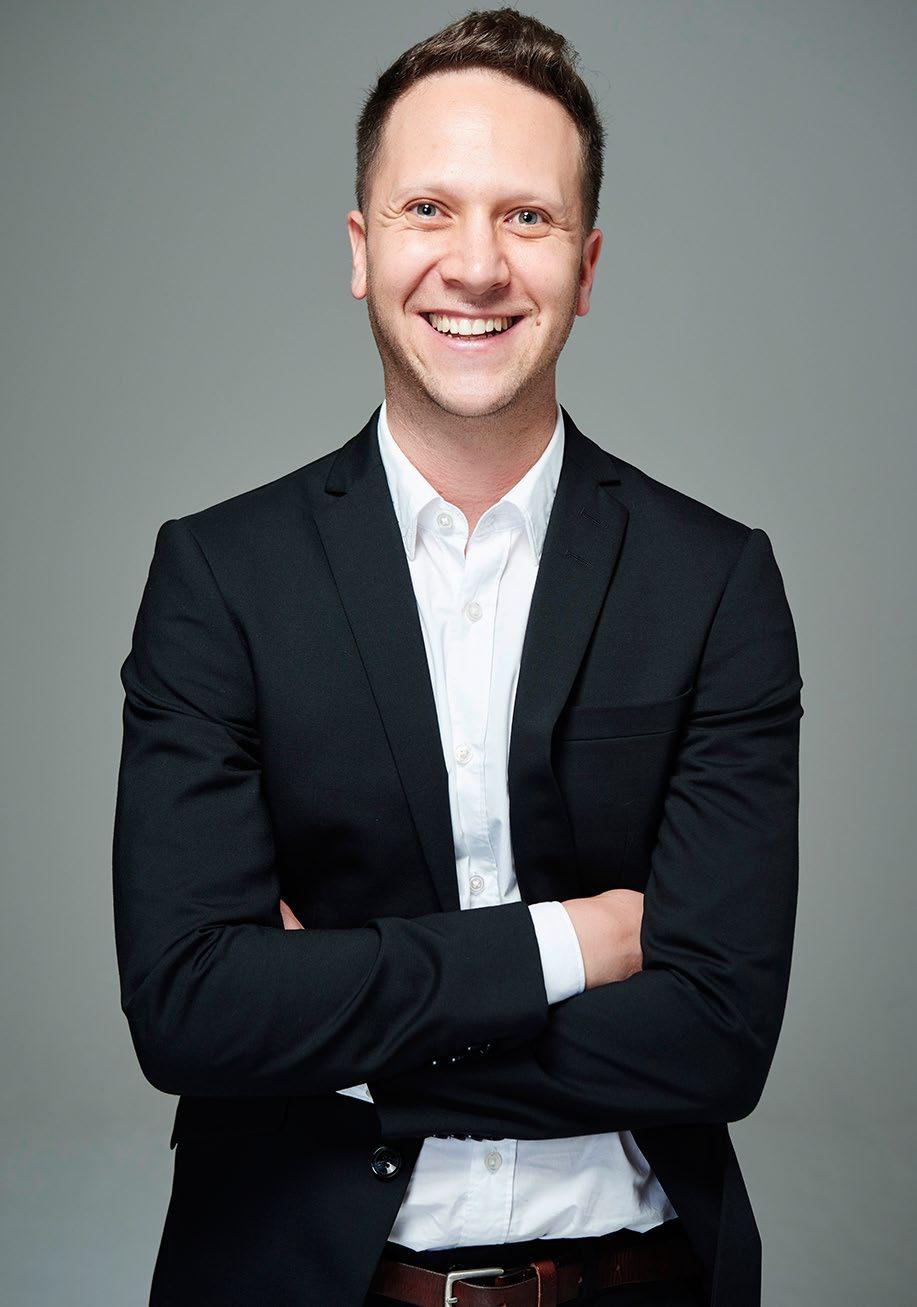
The reality is that hundreds of thousands of South Africans su er in silence because they are too embarrassed to ask for help, they don’t know how or where to get help or they simply can’t a ord to get help. This is when the Panda team realised enough was enough and drove the primary objective behind the app to provide as many people as possible with access to a supportive com munity where they can get treated and get better. Lits and his business partner Allan Sweidan, a clinical psychologist, knew the way to do this was through technology.
“Anyone with a smart phone can access the Panda app. We have made the platform so easy to use so that we can try to democratize access to mental health support and help people nd the right care at the right time, says Lits. “Since launching Panda, we have gained valuable insights into what ails our nation from a mental health perspective. Our data has revealed a critical need for support for anxiety, depression, exam stress, sleep-deprivation and self-esteem. By far the biggest issue people deal with is anxiety, overwhelmingly a ecting younger age groups” he explains.
According to the World Health Organization
(WHO), during the rst year of the Covid-19 pandemic, people su ering with anxiety and depression spiked by 25%, the majority being women and young people aged 1825. This, along with ndings from the Mental Health of the World report 2021 that record ed South Africans as having the lowest mental health quotient score in the world, means our country is facing a mental health crisis that very little is being done about.


This is evident in South Africa where suicide is the second-leading cause of death among those under the age of 29, taking the lives of 23 South Africans every day. For those grap pling with poverty, unemployment and violence, the risk of suicide is even higher. With 9 out of 10 people who die by suicide being found to have su ered from a mental disorder, often unnoticed, undetected, and untreated, it is time to break down the barri ers that prevent them getting help.

To help curb the broader mental health crisis, Panda has made a wide range of assessments available on its app so that users can better understand and proactively manage their mental health. Importantly, the app provides users with personalised recommendations about how to take the rst step to manage their mental health jour ney.
Below are key benefits of using tech nology for mental health support:
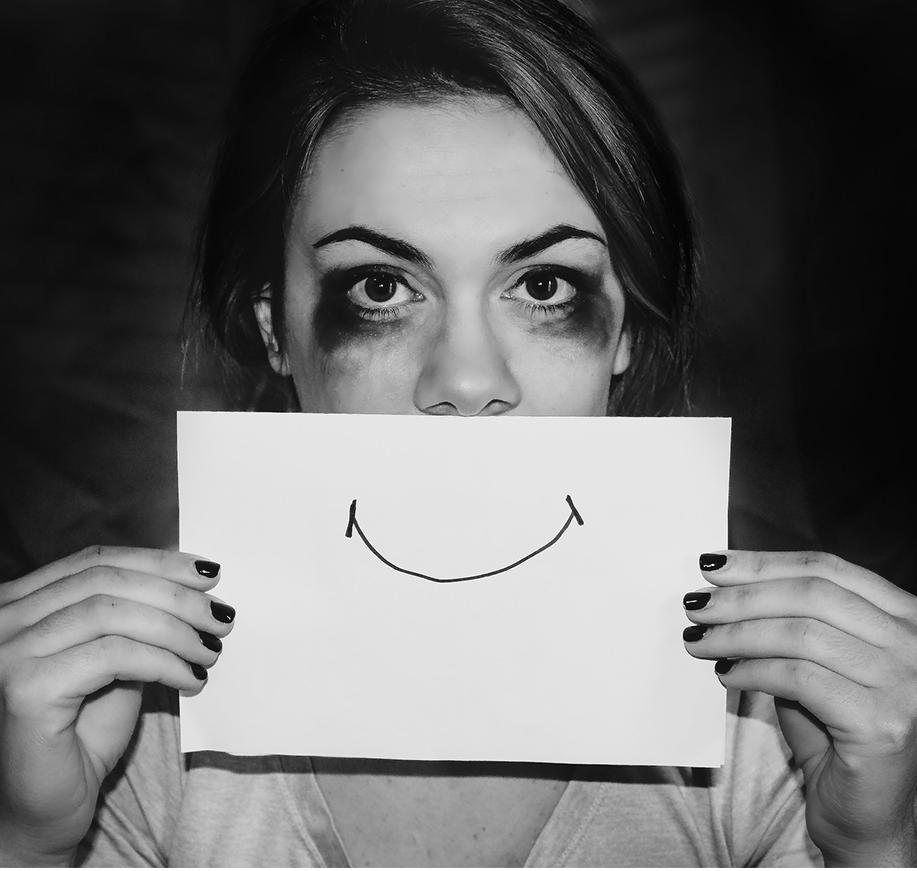
1. Support for anyone, anywhere – tech nology means more people can access help, no matter their location. As long as they have a smart phone, and access to internet, support is in the palm of their hands.
2. More affordable – the Panda app is free to download, access to live-interactive group sessions, content and assessments are free, and they also o er low-cost 1:1 inter
vention in the form of text-based chat support.
3. Anonymity – while the Panda team hopes to reduce the mental health stigma, it still exists and there are people who would prefer to remain anonymous when seeking help. Technology enables this.
4. Helps sufferers take the first step to get help – technology provides a platform for mental health su erers to take the rst step to get the care they need. It can be intimidating to make an appointment with a mental healthcare professional, technology removes this barrier and makes it easier to join a live session and listen or review content in your own time.
5. Convenience – support sessions are within reach of users and can take place anytime, anywhere and is the answer for those who are intimidated by in-person appointments.
October puts the spotlight on Mental Health Awareness, and two of the essential aspects of healthy mental wellness are sleep and staying active; Psychologist and Wellness Coach Dr. Eugene Kemp adds, “it helps with interrupting destructive patterns and obses sive worrying about something by changing the focus.” “You need to make it a priority, which often starts with being more aware, mindful and attentive with your approach. In terms of exercise, make sure to plan it into your schedule; give it a speci c time slot and dedicate yourself to it - focus on the advan tages of prioritising it.” he adds.
When we don’t make sleep and exercise a priority, we see an increase in psychiatric conditions, “which can exacerbate the symp toms of many mental conditions including depression, anxiety, and bipolar disorder” says Dr. Kemp.
Dr. Daniel Amen, an American Psychiatrist, recently said that exercise, when measured as an antidepressant, goes head to head with pharmacology when treating depres sion, so it's proven to be an e ective means to support not only your mental but also physical health.“When it comes to exercise, if you’re feeling low, we know it can be a chal lenge to even think about prioritising tness; however, you don’t have to go all out, Ignite Fitness has classes and facilities that cater to your every tness need. You might nd that kicking up your training a notch in the Rumble arena is exactly what you need. Alternatively, If you’re just coming to the gym to get support and to join a community of like-minded people, the group class concept that we have to o er might be exactly what you need. Whatever gets you moving will surely bene t your mind and body.” says Kerry-Anne Mathieson, Head of Marketing at Ignite Fitness. With sleep being one of the most important activities you do
in a day, right up there with eating, we need to ensure we create the ‘perfect sleeping environment’. “The ‘perfect’ environment doesn’t necessarily exist because everyone prefers it di erently. It’s not impossible to try, though!” says Rudo Kemp, Founder of Sloom - the only comfort adjustable mat tress in South Africa.
“However, the one constant is a quality mat tress and pillows - both need to support your preferred comfort as well as your body (and its shape). I launched Sloom because I wanted to create one bed that could deliver the perfect restful environment for everyone - from support to comfort, to delivery straight to your door.” he adds.
“To add to your sleeping comfort, ideally you want breathable bedding, so Cotton or Linen is always a win, but not a must. In terms of room temperature, our bodies prefer sleeping in a room that is around 23-degrees. This can either be accomplished by an aircon or managed through opening or closing windows and using thicker or cooler curtains. In terms of light, some love it pitch dark and others prefer the room to have a glance of light coming in. However blue light from screens is not suggested prior to sleep; It’s 100% preferential to the sleeper.” he adds.
Now, how does one start incorporating better sleep habits into your routine and why is this important?
Researchers have noted that sleep links to several brain functions, including:
* Memory: Sleep disruption may a ect memory processing and formation.
* Performance: People’s performance at work, school, and other settings are a ected by sleep disruption. This includes focus,

emotional reactivity, decision-making and risk-taking behaviour.
* Cognition: By a ecting stress hormones, sleep disruption may a ect your thinking, judgement and problem-solving ability.
“The rst step to start incorporating better sleep habits is to be aware of the many advantages and then to plan your routines around that.” says Dr. Kemp. “When a person starts to experience the bene ts of sleep, it will become easier to prioritise.” he adds.
Dr. Eugene Kemp shared some of his top tips on managing your mood and mental well ness:
* Realise that emotions/moods are a result of one’s thinking. Negative emotions follow negative thinking.
* Interrupt the negative mood by calling a timeout and focussing on something totally di erent (and more positive).
* Acknowledge the emotion, work through it and move on.
* Remember, you are more than your emo tions!
When you know of someone going through a di cult time, Dr. Eugene Kemp suggests the following for support:
* In most cases, just be present!
* Be willing to listen without making a value judgement.
* Emphasise that it is ok to be vulnerable, and that no one can take away your feelings and emotions. They are valid!
* Support them to get further help if neces sary.
Health is Wealth and by prioritising your sleep and tness schedules, you are also prioritising your mental - and physical health. Now that’s something we can all get behind.

A new UK study has found that women with type 2 diabetes (T2D) may live ve years less than average; and being diagnosed with type 2 diabetes at a younger age may reduce life expectancy by more than eight years.
The research presented at the European Association for the Study of Diabetes Annual Meeting in Stockholm, examined data from over 12 000 English patients with T2D over a ten year period and found that the risk of early death was 84 percent higher in people with diabetes.
Women with T2D had a sixty percent increased chance of an early death and may live ve years less than the average woman, while men with T2D had a 44 percent increased risk of an early death and may live four and half years less.

Smoking shortened life expectancy of people with T2D by 10 years and being diag nosed with T2D before the age of 65 reduced life expectancy by over eight years.
South Africa has one of the highest rates of diabetes in sub-Saharan Africa. An estimated 4.6 million South Africans have diabetes, half of whom are undiagnosed. And at least 95 percent of diabetes is caused by being over weight or obese, an issue that a ects half of all South African adults.
Health expert, Vanessa Ascencao says that diabetes is one of the leading causes of death worldwide and Covid-19 has high
lighted the signi cant burden of the disease, but it can be managed by following a holistic approach to health.
“Optimise your heath by maintaining healthy blood sugar levels and a healthy weight whether you have diabetes or not. At least 80 percent of people with prediabetes are unaware that they have it, so make sure to follow a healthy diet rich in nutrients and foods as close to nature as possible,” said Ascencao.
“Increase intake of fruit and vegetables, healthy fats, lean protein, fatty sh, brown rice, legumes and beans. Plan healthy meals
ahead, exercise regularly, manage stress, avoid processed and sugary foods, avoid smoking and try high quality supplements like nutrient dense, 100% nature-based Marcus Rohrer Spirulina,” she added.

“Studies show that spirulina has powerful antioxidant and anti-in ammatory proper ties. It’s shown to help balance blood sugar levels and blood pressure in patients with T2D and may reduce blood lipids and triglyceride levels which protects against heart disease and metabolic syndrome. Marcus Rohrer Spirulina is shown to deliver more key nutrients per serving than any other spirulina,” she said.

You may have started your running journey to improve your tness levels or to make up for that extra slice of cake you had, but besides helping you maintain a physically healthy lifestyle, running helps improve your mental state too.

South African Depression and Anxiety Group (SADAG) Board Deputy Chairperson and Clinical Psychologist at Tara Hospital, Zamo Mbele, unpacks the bene ts of running.

Running reduces stress and strengthens your mind’s ability to deal with psychologi cal tension. When you become mentally stressed, your body produces cortisol, which is the primary stress hormone. However, through physical exercising like running, your body produces less cortisol in reaction to stressful situations, making running a healthy way to deal with mental stress. In therapy, running is encouraged to help with the symptoms of mental illness.
It’s the result of your brain releasing endor phins, which reduce pain, support sleep and improve your mood. Running also increases blood circulation to your brain, which stimu lates the part of your brain that responds to stress, temporarily improving your mood in stressful situations.
Sleep deprivation impacts your mental abili ties and emotional state. Running will boost your body’s serotonin levels, a hormone related to the sleep-wake cycle. A boost in
your serotonin levels improves your brain’s ability to metabolise serotonin and regulate sleep.
Running helps form new brain cells and improves overall brain performance. It increases your heart rate, which triggers a release of noradrenaline, improving cogni tive function and limiting conditions like attention de cit hyperactivity disorder (ADHD), depression, and hypotension.
It also boosts levels of brain-derived proteins in your body, which helps in decision-mak ing, critical thinking, and learning. Running teaches you to concentrate and gives you the determination to overcome obstacles and fatigue while gaining a new perspective on how to deal with problems while expand ing your stamina and improving your prob lem-solving skills.
A single run can boost your creativity for up to two hours. Instead of staring at a blank page and waiting for innovative ideas to come to mind, put on your running shoes and step outside to rejuvenate your body and mind. Exercise also releases dopamine, which stimulates creativity. Running is also a great way to activate the right side of the brain and spark creativity.

Running improves your body image and self-esteem. Being con dent in yourself helps you stay rooted in activities that you love, and it is bene cial to your overall well-being. So, next time you nd it hard to get out of bed and go for your morning run, think about all the bene ts.
Nedbank, through its Nedbank’s Running Club has been involved in running for decades and throughout its partnership with SADAG aims not only to create a lasting impact in the communities its serve, but to bring South Africans together to address mental well-being with running as a catalyst. It is time to Runify around mental health and take the rst step towards a happier, healthi er South Africa. To nd out how to join Ned bank Runi ed in your city, join the Nedbank Running Club on Strava or search #Ned bankRuni ed on social media.
If you or your loved ones are battling with mental health challenges, there is hope. Visit sadag.org for free resources to manage your mental health.
SMS 31393 and a counsellor will call you back or call 0800 567 567 – available seven days a week, 24 hours a day. SADAG has a dedicated WhatsApp counselling chat line on 087 163 2030 available seven days a week, from 08:00 to 17:00.
Cape Town, October 2022 – More than four million South Africans may be living with osteoporosis, however, many people only nd out when they have experienced severe fractures.

As South Africa marks World Osteoporosis Day on October 20, the National Osteoporo sis Foundation of South Africa has launched Your Bones Matter - a national campaign to advocate for better approaches to diagnos ing and treating osteoporosis patients.
Osteoporosis is a disease that deteriorates bone tissue and weakens bones. Its risk factors include medical and chronic condi tions like HIV, cancer, rheumatoid arthritis and early menopause. It can lead to fragility fractures, which not only severely a ect quality of life but can also increase the likeli hood of premature death. The two most common osteoporotic fractures are of the vertebra, and of the hip. Patients with hip fractures have a 20-30% increased risk of death within a year of their rst fracture.
While it is not always easy to avoid bone density loss, the good news is that early diagnosis and a good treatment plan can prevent about 70% of osteoporotic fractures, helping patients to live longer, better, more ful lling lives.
According Tereza Hough, CEO of the NOFSA, there are several ways to prevent the life-al tering impact of osteoporosis. “The best thing you can do to improve your bone health is to take action quickly,” says Hough. “Speak to your doctor about your risk


factors, ask for a bone density scan, stick to your prescribed treatment plan and follow a bone-healthy lifestyle to reduce your risk of fractures.”
However, despite patients’ best e orts to manage their bone health, they often need intensive treatment which involves hospital isation and surgery. For patients over 45, osteoporosis accounts for more days in hospital than diseases like breast cancer or diabetes, or treatment for heart attacks.
Hough says treatment is expensive and medical aid schemes often fall short in providing for osteoporosis patients. “While medical aids will pay for procedures, like surgeries to treat fractures, , they don’t pay for the medication patients need to prevent future fractures. We need urgent action to change this because our patients deserve better.”
Thecla Macdonald, a pensioner from a small town in the Western Cape, is one such patient. Diagnosed with osteoporosis nearly 20 years ago and oesophageal cancer a decade later, she fractured her spine. “While
I was getting radiation I broke my spine which was extremely painful. Now, I am scared to fall because if I break a hip there’s a big chance I won’t survive,” says Macdonald.
She is trying her best to prevent more fractures but hopes that medical aids would provide better care for patients like her: “I take my medication regularly but it is expen sive and medical aid doesn’t pay for it. It
must cost them a fortune to keep us in hospital when we have fractures so it would make more sense for them to pay for the medication we need.”
Stories like Macdonald’s motivate NOFSA to continue using campaigns like Your Bones Matter to raise awareness of osteoporosis and advocate for patients’ access to medica tion.
“Osteoporosis is a neglected disease area and unless our government and medical aids commit to improving the way we care for patients, many more lives will be a ected by this debilitating disease,” says Hough.
For more information, contact the National Osteoporosis Foundation of South Africa (NOFSA) help line at 0861102265, WhatsApp 068 491 3543 e-mail info@osteoporo sis.org.za, visit https://osteoporo

“At that time, I thought psychiatrists were for people who needed serious intervention and help. I didn’t think that included me, and I did not want to waste their time with my ‘silly’ problem,” recalls Michelle. Michelle, whose name has been changed to protect her and her family’s privacy, has emerged from years of crippling addiction to prescrip tion medicine and alcohol, and debilitating anxiety.
This World Mental Health Month she is shar ing her personal journey to regaining control of her life, hoping to reach others who may be on a similarly destructive trajec tory and encouraging them to seek help before reaching crisis point.
“Over a number of years, I became progres sively more overwhelmed and anxious, and I was starting to have panic attacks. Everything was an e ort, and I felt like my days were all black. It got to a point where I was unable to drive, stand in queues, be in a crowd and sometimes I could not even leave home. By 2005, anxiety was completely dictating my life.”
Peta-Lyn Foot, COPE manager and occupa tional therapist at Akeso Randburg – Cres cent Clinic, notes that mental health issues are often misunderstood, delaying or preventing people from accessing treat

ment. “Even though there is more awareness and open mindedness about the impor tance of mental wellbeing generally, in some families and particularly among older gener ations there is still a lot of judgement and stigma attached to seeking help,” she says.
“There is often a misplaced belief that people experiencing mental health di cul ties have the option to ‘just get over it’, with out fully realising the complexities of recov ery and that it usually requires professional assistance.”
ʻSomething to take the edge offʼ
Michelle describes how she was rst intro duced to the medicine she later became addicted to. “I spoke to my gynaecologist about the way I was feeling after the birth of my rst baby. I thought there was no way I needed antidepressants, I just wanted some thing to ‘take the edge o ’. She prescribed a certain medication and, at rst, I thought ‘What an incredible little pill’. It made me feel ‘normal’ again, and I could do everything and more – for a while,” she remembers.
“During this time, I managed to justify how the medication had become my answer to living a normal existence. I was under so much pressure in my relationship with my husband, raising a family, and coping with a demanding job, so I felt I could use it as a crutch for a short while. One little pill soon turned into two, then three, then four to
have the same e ect. I was completely addicted, and I knew it. I felt completely helpless.
“I tried to wean myself o the medicine several times without success, it completely controlled my waking hours. Even though I was taking the maximum daily dose, my anxiety and panic attacks returned with a vengeance.”
Michelle realised she could not keep taking the medicine, and instead of seeking profes sional help she tried to self-medicate with another substance: “Alcohol was the answer, a glass of wine at night helped me to relax and get a good night’s sleep. Then a glass of wine at lunch helped with the anxiety of the afternoon. Soon I was drinking throughout the day, and still my anxiety and panic attacks continued. I was a wreck. I hated myself, I didn’t know how I could do this to my precious children,” she recalls.
"Eventually, my self-worth and self-esteem were non-existent, and I knew I had two choices, either death or professional help. I thought of my precious children and knew I needed to get professional help,” Michelle recalls of that dark time in her life. “And so, in 2012 my life took a drastic turn for the
better. I was admitted to Netcare Akeso Randburg – Crescent Clinic for three weeks of rehabilitation in the dual diagnosis unit for panic and anxiety disorder and alcohol ism. I had been in another mental health facility years before but lapsed after my discharge as the facility did not o er a support programme after discharge from the inhouse stay.”

“People often have reservations about admitting that they need help in the rst place, and therefore don’t get the help they need when they rst develop dysfunctional coping mechanisms or start feeling symp toms of stress, depression, anxiety or other mental health concerns,” Foot points out. “Recognising that you need and deserve professional help is the rst step. Unfortu nately, all too often people only access the mental healthcare they need once their substance use or other disorder has progressed to become so intense that it starts a ecting other people at work, in relationships or within families. Eventually, all areas of the person’s life can be impacted, including their physical health and hygiene.”
The dual diagnosis units at various Netcare Akeso mental health facilities run 21-day inpatient programmes involving a multidis ciplinary team of psychologists, psychia trists, occupational therapists, an addictions counsellor, a general practitioner, and a social worker, where required, who work closely together with the individual to provide comprehensive treatment to help
them regain control of their lives. “We all wish there was a quick x – a pill that would take all our problems away – but recovering from addiction and underlying mental health conditions is a process that requires work. We help teach clients the skills to cope, however the person needs to be willing to accept help and take responsi bility for their actions to commit to their long term recovery,” Foot says.
“By my third week in Netcare Akeso Rand burg – Crescent Clinic, I was able to smile with honesty and cry with real tears, I found emotions that had been buried so deep I was not sure they still existed. I saw colour in the world again,” says former patient Michelle, who has now been in recovery for more than 10 years. “After I was discharged, I became independent again. I disconnected from all the friends that had encouraged my addictive behaviour and reached out to my family for support and embraced holistic therapy. Within a few months I was back on my feet, and still am. Continuing to regularly consult my psychiatrist and psychologist at the Netcare Akeso facility at rst helped me keep my resolve and I now check in when I need to. Trust me, it was not easy in the beginning, but it got easier and easier.”
Foot adds: “It is an ongoing process, and we encourage clients to continue their progress after the inpatient programme. We under stand it is more challenging to take time for
yourself when life is busy and stressful. We also recommend regular follow up sessions with a mental health professional on an outpatient basis, and this provides a dedi cated space for the person to work on their recovery and resilience.”
She also advises setting a daily routine. “Although life isn’t always predictable, having a routine helps us to focus and regain a sense of being in control of our lives, so that we are more prepared when we encounter tough times. Taking things one step at a time also makes a situation feel more manageable once you have the tools needed to cope when life throws something unexpected our way.

“Check in with yourself regularly and look for help in the right places, you can’t expect it to come to you. Family alone may not always be able to provide the kind of support you need. Support groups, such as those organ ised by Alcoholics Anonymous, Narcotics Anonymous and the South African Anxiety and Depression Group can be invaluable for empathetic support from individuals who have walked the same path.”
For information about mental health and services, and accessing care, or for help in an emotional crisis, Netcare Akeso is here to help. In the event of a psychological crisis, individuals can phone the Netcare Akeso crisis helpline on 0861 435 787, 24 hours a day, to talk to an experienced counsellor.

Three women healthcare professionals have united to ght breast cancer – the most common cancer globally – raising awareness this Breast Cancer Awareness Month of the importance of regular mammogram screen ing to help improve survival rates.
“Having a screening mammogram can feel daunting but it should rather be seen as a vital component of regular health screen ings that can help to prolong or even save your life by detecting cancer early,” says Dr Heleen Hanekom, a radiologist with special interest in breast imaging, who practises at Netcare Unitas Hospital as part of Drs Burger Radiologists Incorporated.
Dr Hanekom, together with clinical and radi ation oncologist Dr Rouchelle Marais and specialist breast surgeon Dr Lucienne van Schalkwyk are specialists who are passionate about prioritising breast health and making the journey of breast cancer treatment as unintimidating and e ective as possible. Together, they have put this into practice by establishing a dedicated breast care team at Netcare Unitas Hospital.
“Mammography remains the best screening option for women as it is the only method of breast imaging that has consistently been shown to improve breast cancer mortality rates,” Dr Hanekom says.
“Monthly breast self-examination is also important, however with regular mammo grams, ideally annually, we can detect breast cancer at the earliest possible opportunity, often before it is palpable.”
Dr Van Schalkwyk adds that the earlier breast cancer is identi ed, the more options are available to manage the condition. “Some women report procrastinating about having a mammogram because they have experienced discomfort in the past, however the risk is simply too great for women over the age of 40 for regular mammograms to be ignored or postponed,” she says.
Most women nd mammograms somewhat uncomfortable, but here’s what you can do if you found it more painful:
1. Try not to schedule your mammogram
during, or in the week leading up to your period when your breasts may be swollen and uncomfortable.
2. Ask your family doctor about options for safe over the counter pain relief, and take it about an hour before your appointment.
3. Having moral support at the appointment can help to reduce anxiety, take a friend or loved one with you.

4. Try to relax, take deep breaths and use mindfulness techniques to help you remain calm before and during your mammogram.
5. Keep your body and feet turned towards the mammogram machine to avoid pinch ing, as well as neck and back discomfort.
6. Mammograms can be performed while you are seated, if you are unable to stand or are uncomfortable standing.
7. If you experience discomfort at any time during the positioning for the mammogram, let the radiographer know as they may be able to make small adjustments to make you feel more comfortable.
Taking the ʻWhat ifʼsʼ together
“Taking care of your breast health is a neces sary part of your health routine, and regular mammograms are recommended for all women from the age of 40 onwards. Your doctor can guide you as to how often you should be screened. If something is detected that requires further investigation, there is
so much more that can be done today to treat breast cancer. The earlier a lesion is identi ed, the more treatment options there are available,” Dr Van Schalkwyk says. “Almost the entire team are women, and we understand that screening, diagnosis and treatment for breast cancer can be very daunting so we have made the environment as supportive as possible for the patients we serve,” she says.
The dedicated breast cancer team estab lished at Netcare Unitas Hospital has a multi disciplinary approach to treating breast cancer, and the care provided is aligned with international best practice guidelines. This may include more specialised imaging or image guided biopsy, radiation therapy, chemotherapy, surgery, or a combination. “Each patient is a key member of the treat ment team along with the medical special ists from various disciplines. Multidiscipli nary care ensures that treatment decisions can be reached without wasting the patient’s time or money, treatment progress can be monitored and the plan can be revised if needed,” Dr Van Schalkwyk adds.
“Awareness and regular mammograms can go a long way to minimising the impact of breast cancer on individuals, families and society. Stay abreast of your health screen ings, as a few minutes can bring you great peace of mind.”


South Africa’s leading natural wellbeing and lifestyle retailer, Wellness Warehouse is thrilled to announce their latest all-natural beauty collection – the Rejuvenating range.

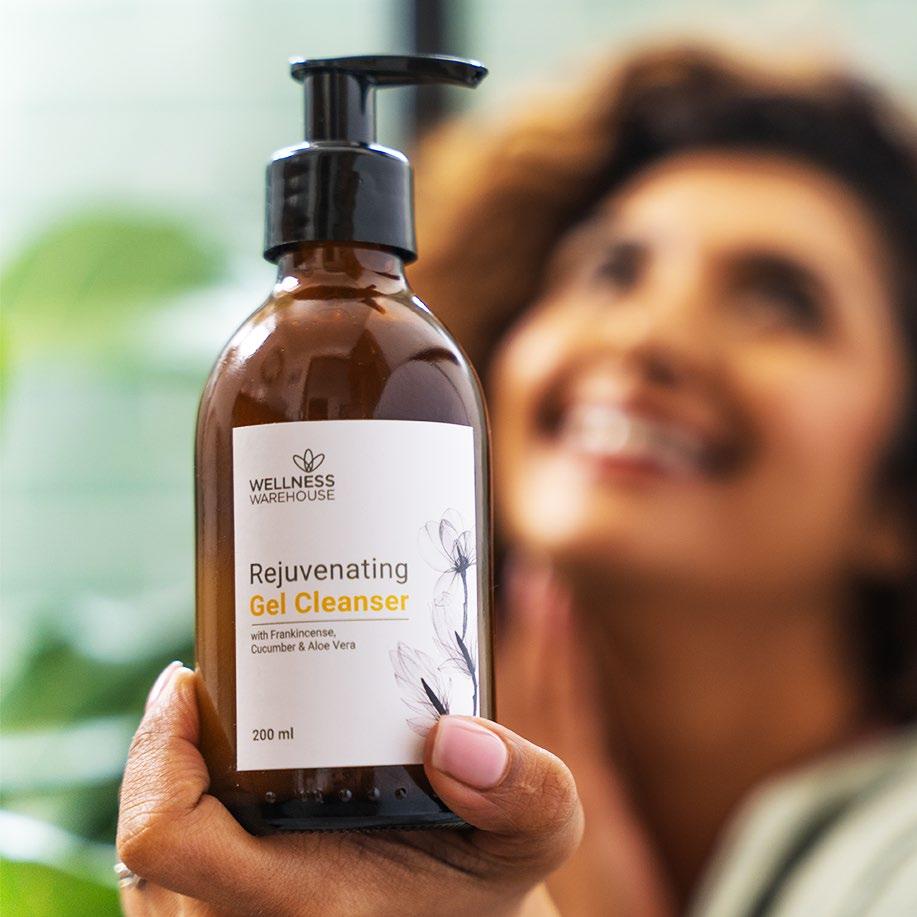
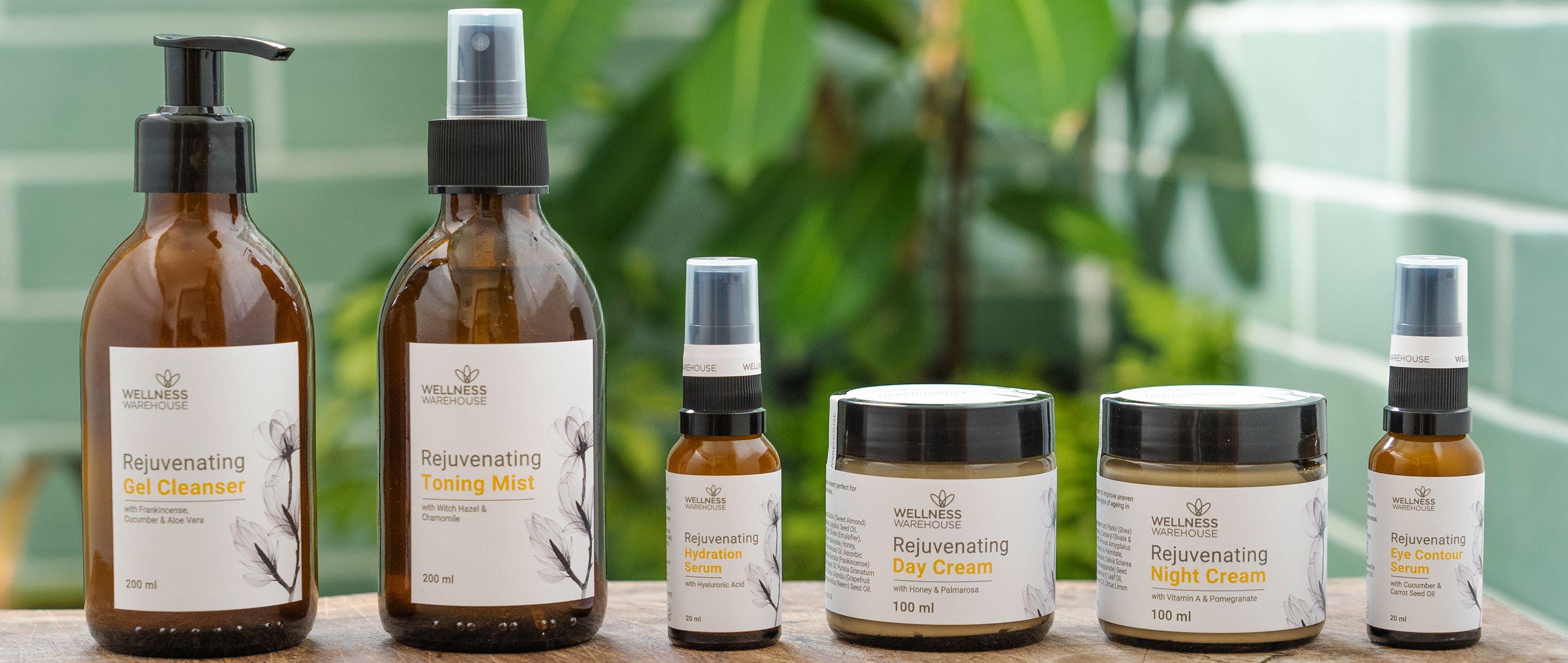
The conscious brand’s answer to their customers’ ever-increasing interest in chem ical-free, eco-friendly personal care prod ucts, the range combines pure ingredients from nature with the latest in scienti c advances for skincare that is both gentle and e ective.
The exciting addition to their already popu lar beauty and personal care range, the Reju venating collection has been crafted with expert care and quality ingredients to bring customers products that are 100% natural, cruelty-free, and safe for use on all skin types. In line with Wellness Warehouse’s e orts to make all facets of wellbeing acces sible and a ordable, the products are com
petitively priced, without compromising on quality.

Star ingredients include calming chamomile; cooling cucumber; clearing witch hazel; fragrant frankincense; hydrating aloe vera; healing palmarosa; protective pomegranate; restoring vitamin A; antioxidant-rich carrot seed oil; anti-ageing hyaluronic acid; and more.
Every step of a daily skincare routine has been accounted for, with a Gel Cleanser to remove impurities; a Toning Mist to help calm irritation; a Hydration Serum to nourish and protect; an Eye Contour Serum to brighten and plump; a Day Cream to restore dry skin; and a Night Cream to improve uneven skin tone and help to combat the signs of ageing.
Packaged mostly in glass and recyclable plastic and card, the range is sure to delight
conscious consumers with its quality, purity, and results.
Natural Beauty Merchandise Manager Shamiyah Vawda shares:
“Say hello to our newly launched Rejuvenat ing skincare line! Our product development team has spent thousands of hours researching and perfecting the formulation. The result? An indulgent and e ective natu ral skincare range for all. The star of the show and the buyer’s choice award goes to the Rejuvenating Hydration Serum - a powerful ly moisturising serum perfect for tired and dry skin. Its lightweight formula absorbs instantly into the skin, leaving no greasy residue behind. The magical ingredienthyaluronic acid - rms and plumps, leaving skin feeling and looking healthy. Combine this amazing product with the rest of the range to achieve ageless beauty.”
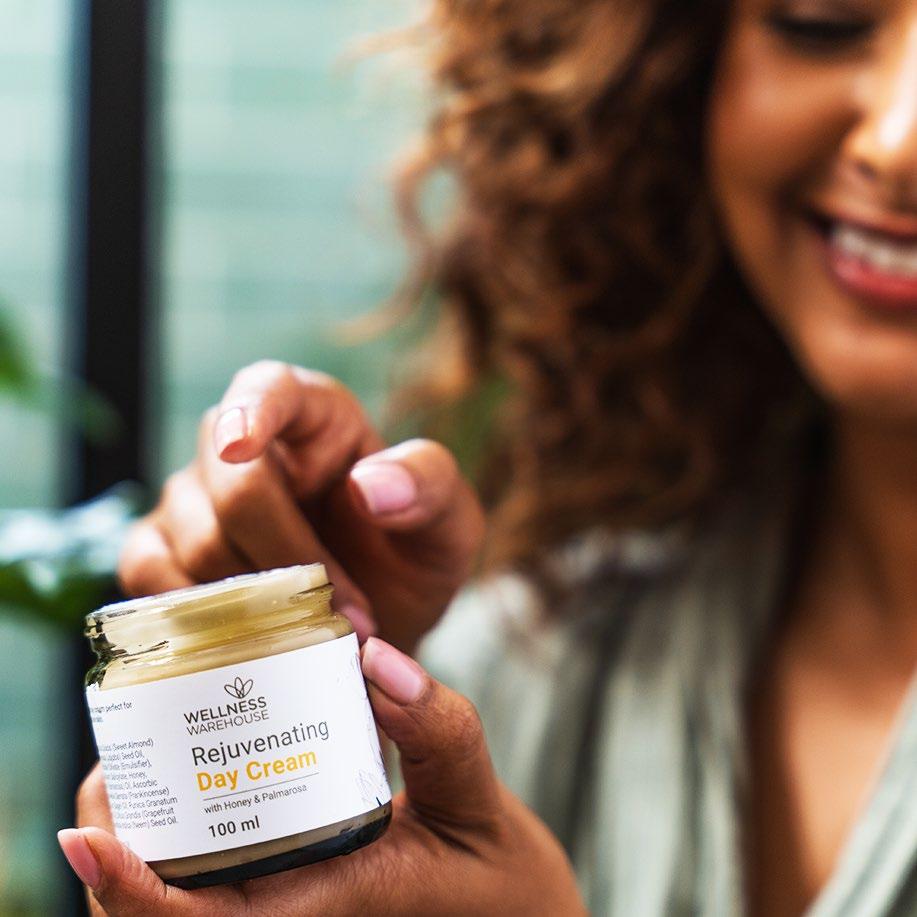

October is Breast Cancer Awareness Month, and although your oral hygiene may not seem like a priority when you are battling cancer, about a third of patients will experi ence oral complications. Mouth ulcers, dry mouth, cracked lips and dental disease are top of the list.
“Chemotherapy, other medications and radiation can upset the balance of bacteria in your mouth, limit your body’s ability to ght infection and dry out the mouth,” says Dirna Grobbelaar, Ivohealth oral hygiene advisor. “Unfortunately this can make you more susceptible to cavities, gum disease and infections. Maintaining an e ective oral care routine is important for your over all health and well-being, even when you’re not feeling well.”
To help you take good care of your mouth during cancer treatment, Ivohealth has compiled easy-to-follow advice from dental and other medical professionals in a guide Love your Life, Love your Oral Care which can be downloaded for free. Grobbelaar shares some of the most important advice:
A dry mouth, medically known as xerosto mia, is a common side-e ect of many medi cations and radiation. Because saliva is the body’s way of naturally cleaning the mouth, plaque and bacteria build up more quickly, putting you at higher risk of bleeding gums, bad breath and dental decay.
Rehydrating your mouth is a priority. Drink ing water will give temporary relief; an oral lubricator like GUM Hydral spray and gel will last longer. Chewing sugar-free gum can stimulate saliva ow and some medica tions can help produce saliva; ask your pharmacist or healthcare professional for advice.
Many cancer patients experience mouth ulcers which make eating, talking and cleaning the mouth uncomfortable. Use Aloclair gel or spray to create a ‘barrier’ over the ulcer for immediate relief and promote faster healing. And don’t be tempted to skip your oral care routine because your mouth is sore; keeping it clean can help prevent further infection.
Protect your lips with a lubricating barrier to prevent them from becoming dry and cracked. Licking your lips can exacerbate dryness. Rather regularly apply a moisturis ing balm, like Letibalm nose and lip repair, and drink plenty of uids to keep the mouth and skin hydrated.
Gum disease, dental decay and cavities are all common dental problems during cancer treatment. These are best prevented with an e ective daily oral care routine and professional support. Visit your dentist for a thorough check-up before your treatment starts, to detect and treat any existing issues. See the oral hygienist for a profes sional cleaning at the same time. Removing plaque and tartar build-up means your mouth is in tip-top shape at the onset.
Some patients experience nausea during treatment. Vomiting demineralises teeth enamel and weakens the teeth. Don’t brush your teeth immediately after vomiting. Simply rinse with water or an alcohol-free mouthwash with uoride, like Dentyl Active or GUM Paroex with antibacterial CPC, then wait an hour or so before brushing.
Recommended Daily Oral Care Rou tine during Cancer Treatment: A few minor adjustments to your daily oral care can make it easier and more e ective. Here’s the routine recommended during
cancer treatment from Dirna Grobbelaar, Ivohealth’s oral hygiene advisor:

1. Brush correctly at least twice a day for a full two minutes each time. You may be tired. A quality electric brush, like Philips Sonicare or GUM Sonic, will give a ‘supreme clean’ with minimum e ort. Dip the brush in warm water to soften the bristles, or use an ultra-soft brush like GUM Sonic Sensi tive.
2. Look for mild or pleasant-tasting tooth paste that has multiple bene ts. GUM Paroex Intensive Action has anti-bacterial ingredients to help maintain healthy gums. All-natural Olgani Probiom toothpaste and tooth powder have added prebiotics and probiotics for a balanced oral microbiota.
3. Continue to clean between the teeth every day. If you nd oss too rm for sensi tive gums, try an interdental brush like the reusable GUM Bi-Direction with anti-bacte rial coated bristles, or gentle rubber Soft-Picks.
4. After eating or being sick, rinse with an alcohol-free mouthwash like GUM Paroex with antibacterial CPC or Dentyl Active, or use a salt-based mouth rinse like Thryve mouth salts or Olgani.
While cancer treatment can negatively impact your mouth, the right care can help you prevent or manage many of the common problems. Remember, your dental professional is available to support you at this time. Let them know about your diagnosis and treatment.
For further information visit Ivohealth’s website or download Ivohealth’s free Cancer and Oral Care booklet. The Cancer Association of South Africa website also has excellent resources.
Every year, in October, South Africa and the world is ooded with pink ribbons in remembrance of Breast Cancer Awareness Month. But breast cancer is more than just wearing a pink ribbon and going to a Fun Run. Breast cancer is one of the deadliest diseases facing women across the globe. Locally, from 2017 to 2022, medical scheme Profmed found that 10% of female members who claimed breast cancer pay-outs had passed on from the disease.
Unfortunately, breast cancer cannot be prevented. However, Clinical Executive at Profmed Medical Scheme, Justine Lacy, “Detecting breast cancer early increases your chance of survival, as more treatment options are available.”
For this reason, Lacy recommends self-ex amination and routine mammograms as the foundation of every woman's life. “Women between the ages of 40 and 54 years should make an appointment for a mammogram at least once a year, and those 55 years and over should continue getting mammograms every 1 to 2 years. Beyond that, women of all ages should be performing a self-examina tion at least once a month to be safe,” says Lacy.
Lacy advises women not to be complacent about their health. "Don't wait until you
show symptoms to take action. Take respon sibility for your health and schedule a mam mogram as soon as possible."
For her, it all starts with education. Justine Lacy is keen to provide her insights regard ing:
• Signs and symptoms of breast cancer
• Prevalence of breast cancer in South Africa
• Breast cancer trends according to Profmed statistics
• What to do when you are diagnosed
• Various treatment options are available

• What to expect when you go for a mammo gram
Earlier this month, we chatted with Justine and she had the following additional advice:
1. What are the signs and symptoms of breast cancer?
The signs and symptoms of breast cancer are subtle and not always obvious. This is the reason why it is imperative, as women that we are meticulous when it comes to regular self-examination of our breasts and going for our annual checks. This is the only way that we can pick up a problem early and treat it timeously.

One of the earliest symptoms is a new lump in the breast or under the arm – if it’s under the arm it’s usually indicative of swollen
lymph nodes which is a sign that something is amiss.
Other early signs would almost always be local and involve the breast and/or nipple area. These signs would include changes to the skin such as redness, aking, thickening, or dimpling. Breast size may change and there may be swelling, pain and discharge.
Some of the signs of more advanced breast cancer are fatigue, weight loss and loss of appetite to name but a few.
2. What is the breast cancer trend according to Profmed statistics?
Profmed’s reporting is consistent with the national statistics. Of all the types of cancer in our female membership, breast cancer has the highest prevalence, and its treat ment often comes at a high price.
In the 2021 period, Profmed had a total of 943 distinct claiming bene ciaries with a cancer diagnosis. What’s astounding is that 50% of these members had or currently have breast cancer.
In Profmed, breast cancer leads in the Top 5
Oncology Diagnoses based on cost, as well as coming in rst in the Top 10 Cancers based on the No. of Bene ciaries.
We can also reveal that approximately 10% of our members with a breast cancer diag nosis pass away. This illustrates the sad reali ty of cancer diagnosed too late. This matter needs to be taken very seriously as it is a ecting ourselves, our sisters, and our mothers.
Once your doctor has diagnosed your breast cancer, they will establish the extent of your cancer.
You are likely to be referred to an oncologist specialising in breast cancer if you haven’t already got one. Depending on the approach that your oncologist wants to take, you may need more tests and even surgery.
The stage at which your cancer is diagnosed will determine both your prognosis and the best treatment options. Sometimes, this information may not be evident until after you’ve undergone breast cancer surgery. Let’s not forget about the psychological rami cations of such a diagnosis. After nd
ing out you have breast cancer, you may feel shocked, upset, anxious or confused. These are normal responses, but it is important to nd support and talk about your treatment options with your doctor, family and friends and to seek as much information as you need.
There are also many organisations such as CANSA that you can approach for support. CANSA, the Cancer Association of South Africa has a toll-free line and are also availa ble on various social media platforms.
Profmed o ers a speci c trauma counselling programme that provides members with access to counsellors 24 hours a day. We also provide mental health bene ts to our mem bers which vary depending on the option you choose.

Simply put, mammography is usually carried out in the radiology department, the same place where scans and x-rays are done. It is a process that uses low-energy X-rays to examine the human breast for diagnosis and screening. The goal being early detection of breast cancer, which is typically through detection of characteristic masses or micro calci cations.
When you go for a mammogram, you'll be asked to undress above the waist and a radi ographer or technician will give you a gown to wear. You'll then be asked to stand in front of a special X-ray machine. You'll be assisted to place each breast, one at a time on a plastic platform, and the radiographer will lower a plastic plate that presses down on your breast. The whole process lasts less than 5 minutes and really isn’t half as daunt ing as one imagines it to be.
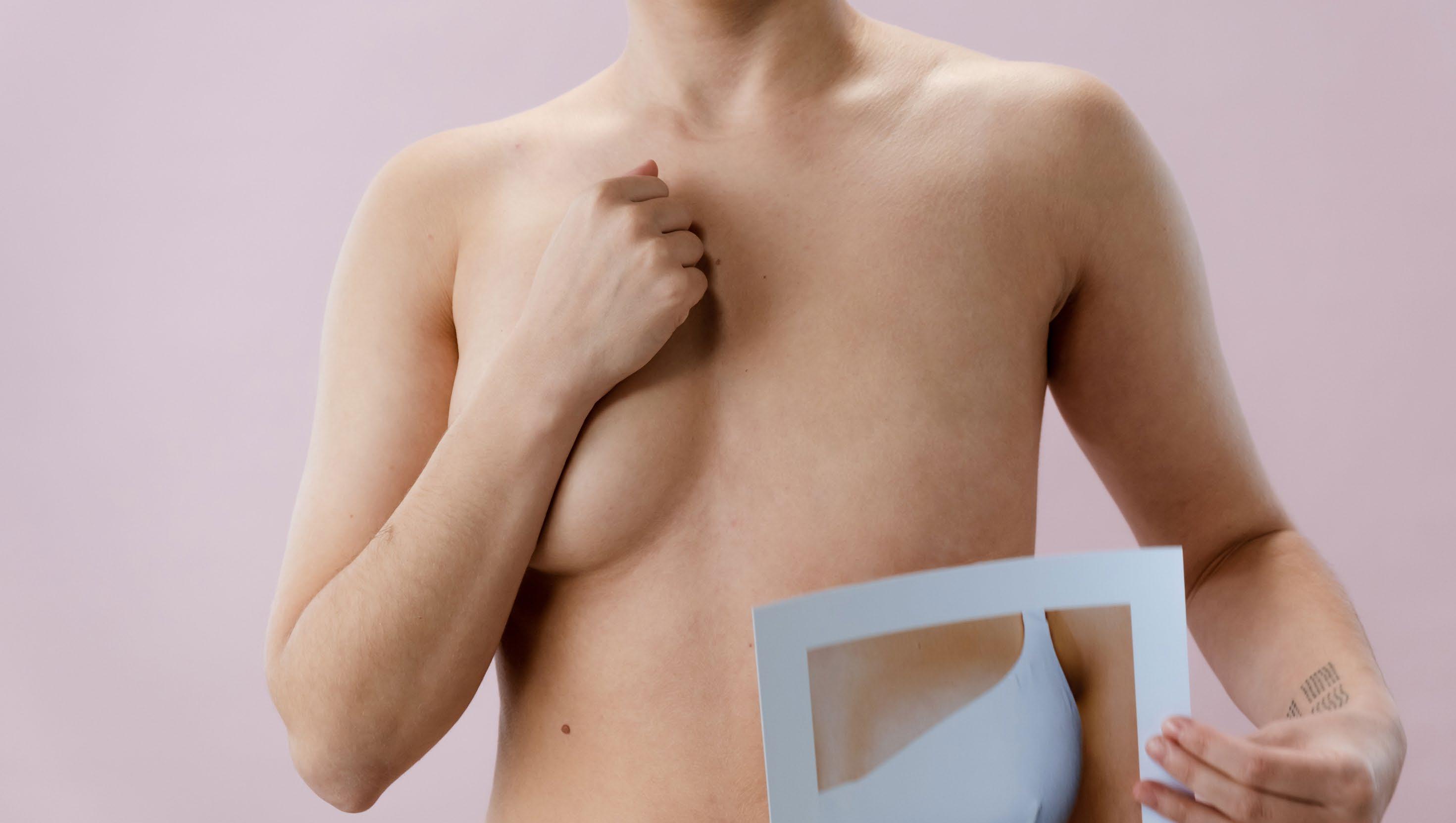
Usually, an ultrasound is done following a mammogram which then allows your radiol ogist to examine the lymph nodes under each arm, as well as the breast tissue for anything that the mammogram may have missed
It is recommended that women with dense breast tissue should have both a mammo gram and breast ultrasound each year and my experience is that radiology depart ments usually do this in tandem. Dense breast tissue is not abnormal or harmful. However, cancer can “hide” in dense tissue because they look the same on a mammo gram image. On an ultrasound, diagnostic radiologists can see what they can't see on the mammogram.
Justine Lacy is the Clinical Executive at Profmed.

A simple R30 transfer will help PinkDrive get the mammogram machine they urgently need
October is Breast Cancer Awareness Month, an annual campaign to raise awareness about the impact of breast cancer. This month’s theme for the national awareness day is ‘Rise’ – with a strong message to ensure every woman has access to the screenings she needs, and the support she deserves.
The South African NPO, PinkDrive, works tirelessly all year round to promote aware ness and early detection of Breast Cancer, and screening for gender-related cancers in the general population of South Africa, focusing on their driving message: “Early detection will help to a prolong life.”
This year, PinkDrive is asking South Africans to ‘Rise’ to the challenge of helping them acquire the desperately needed new mam mography machine for their famous Mobile Women’s Health Unit. This mobile clinic provides screening and education for gen der-related cancers including breast, cervical and prostate cancer to traditionally under serviced communities in South Africa, and they need our help.
According to Noelene Kotschan, CEO and Founder of PinkDrive, a simple online payment of just R30 will help them meet their funding goal for this much-needed equipment. “Just one new mammography machine will make an enormous di erence, and you can be a part of that di erence by
visiting our website and helping us to reach the goal of 100 000 people making a R30 donation – which will cover the R3 million cost of the machine.” Participants will be entered into a draw on 31 October to win two return air tickets with Lift, and two nights stay at the Taj Cape Town.

Kotschan goes on to explain that they are challenging corporates to donate R50 000 or more, and in return, PinkDrive will hold an activation with that company’s branding in a community of their choice. Corporates who donate R100 000 will also be o ered a branded activation in their chosen commu nity, as well as have their branding placed on the Mobile Women’s Health Units for one full year. “Vuma is an example of an organisation that has been a sustainable and committed partner to PinkDrive, which has been invalu able to our e orts to bring much needed health care services to underserviced com munities,” says Kotschan.
Lianne Williams of Vuma says individuals and organisations shouldn’t underestimate how much of a di erence their donation can make. “Every cent that PinkDrive receives is a cent they didn’t previously have, and it goes towards changing – or even saving - some one’s life. We urge South Africans to come together and ‘Rise’ up, to bring critical screening and diagnostics to communities across the country. If we do this together we can help eliminate preventable illness and death,” she concludes.
About Vuma Vuma is a leading South African bre provid
er that has passed more than over 1,5 million homes, with at least a future 2 million homes-passed anticipated in emerging mar kets, since its operations began in 2014. Vuma connects South African communities to high-speed, t-for-purpose internet through open-access bre broadband. Working with more than 60 Internet Service Providers (ISPs), Vuma’s value extends beyond infrastructure and empowers ordi nary individuals and communities across South Africa to do more, see more, and dream of more.
Guided by its philosophy of ‘if we can, we must’, Vuma strives to drive transformation and break communication barriers. The brand has connected more than 600 regis tered primary and high schools in the regions where it operates, to free 1Gbps bre broadband internet. This supports hun dreds of thousands of young people and their teachers through access to the bound less opportunities of the internet, in collabo ration with its partner ISPs.
Among Vuma’s accolades are: South Africa’s Best Fibre Provider in 2019 at the MyBroad band Conference and Expo; Fastest Growing Broadband Provider in 2020 and Best Broad band Provider in 2021 by the International Business Magazine Awards; the Global Economics Award for Fastest Growing Tele communications Company 2021; and Best Fibre Provider for 2021 by MyBroadband. Vuma’s CEO, Dietlof Mare, was awarded Telecom CEO of the Year 2020 South Africa as well as Telecom CEO of the Year 2021 South Africa by the International Business Magazine Awards.

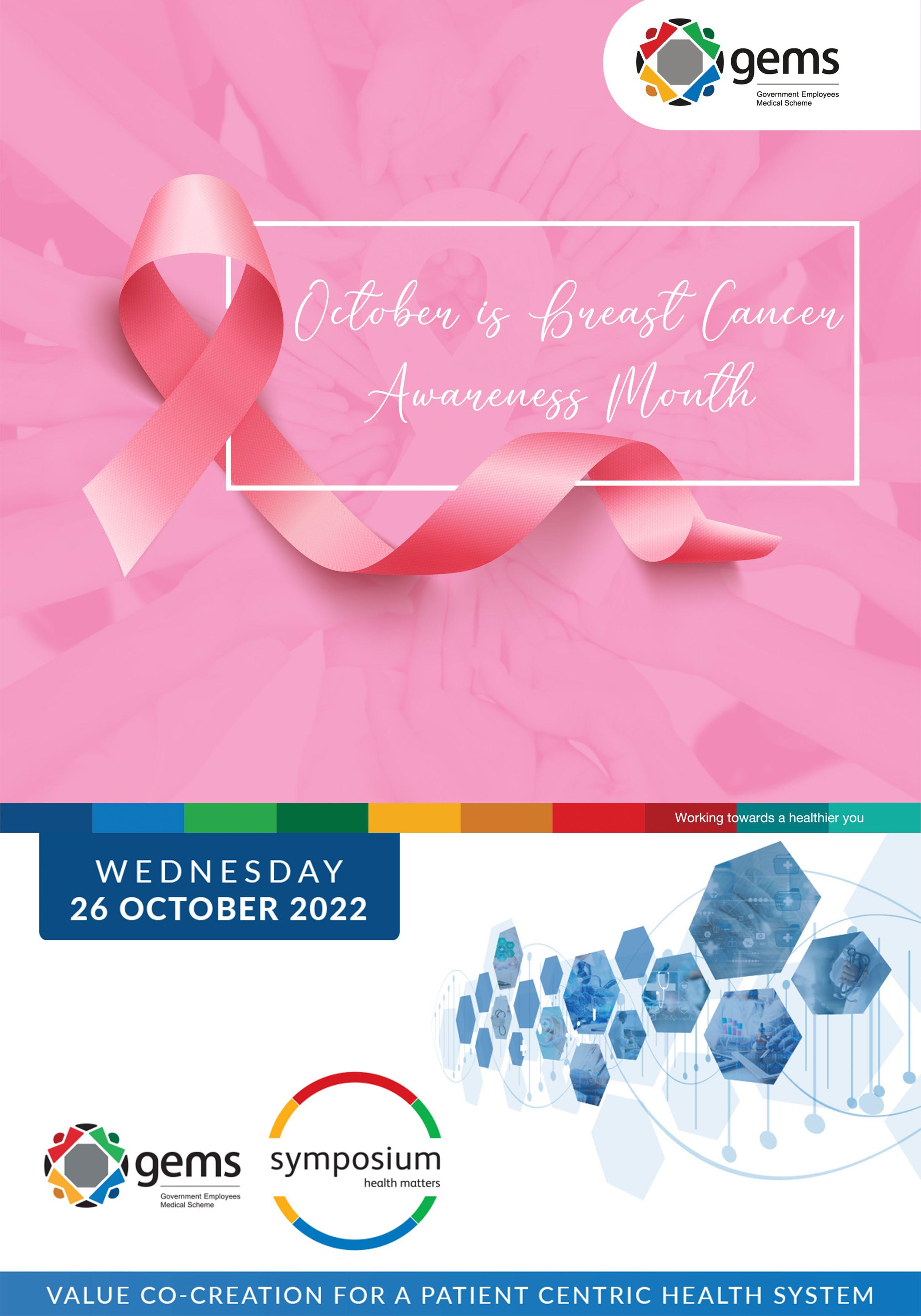
During the 2022 Medium Term Budget Policy Statement, Finance Minister Enoch Godongwana announced that, as the imme diate pressure from the pandemic eases, more resources will be added to the coun try’s health sector so that it can address accumulated backlogs such as for surgery, oncology, antiretroviral treatment and tuberculosis screening and treatment. He also shared that additional funds will be provided to alleviate critical funding pres sures in areas such as healthcare personnel, medicine, laboratory services, medical supplies, and critical goods and services.
Nabiella de Beer, Communications Manager at DKMS Africa, a non-pro t organisation dedicated to the ght against blood cancer and blood disorders welcomes Finance Min ister Enoch Godongwana’s announcement.
“For many patients diagnosed with blood cancer and blood diseases, a blood stem cell transplant from a matching donor is their best chance for survival. But, for far too long, the state has been too overburdened to carry these out, resulting in countless unnec essary deaths. By alleviating backlogs and critical funding pressures, patients could now get a second chance at life.”
She points out that the additions of funds and recourses are crucial because every 72 minutes, someone is diagnosed with blood cancer in South Africa. “As access to medical treatment is a basic human right, the fact that Government is placing focus on bolster ing these areas in healthcare will make a signi cant di erence to lives of those living
with cancer, a leading cause of death in South Africa.”
However, de Beer explains that for those accessing state care, the costs can still be quite unattainable. “This is combined with the fact that the state will only cover stem cell transplants from a family member despite there only being a 30% chance of a patient nding a genetic match within their families, it would be great to see further assistance provided from Government to those needing to access treatment as well as funds being extended.”
Having said this, she adds that we can’t expect the government to act on their own which is why private public partnerships are so essential. “At DKMS Africa, we work close ly with the government to ensure all our patients receive the medical care they need. However, without stem cells we would not be able to provide stem cell transplants which is why we need to South African public to mobilise and register as a donor.”
“This is especially important as even though we are a part of a global registry of stem-cell donors, but unfortunately, those of African descent are underrepresented,” de Beer continues. “There is a dire need for blood donors from ethnically diverse backgrounds as Black, Coloured, Indian and Asian blood cancer patients only have a 19% chance of nding a match, despite representing more than 80% of the SA population.”
De Beer highlights that registering as a
stem-cell donor is easy and pain-free. “All that is required is for three DNA swabs to be taken from the inside of the potential donor’s mouth and cheeks. After this, the donor is given a full doctor’s examination, which includes taking a blood sample. They are then asked to donate stem cells 30 days later.

If you are between the ages of 18 and 55 and in good health, you can register to become a donor at https://www.dkms-africa.org/regis ter-now.

“There can be no greater gift than the gift of hope you will be giving someone su ering from a life-threatening blood disease by donating stem cells and together we can all make a di erence,” she concludes.


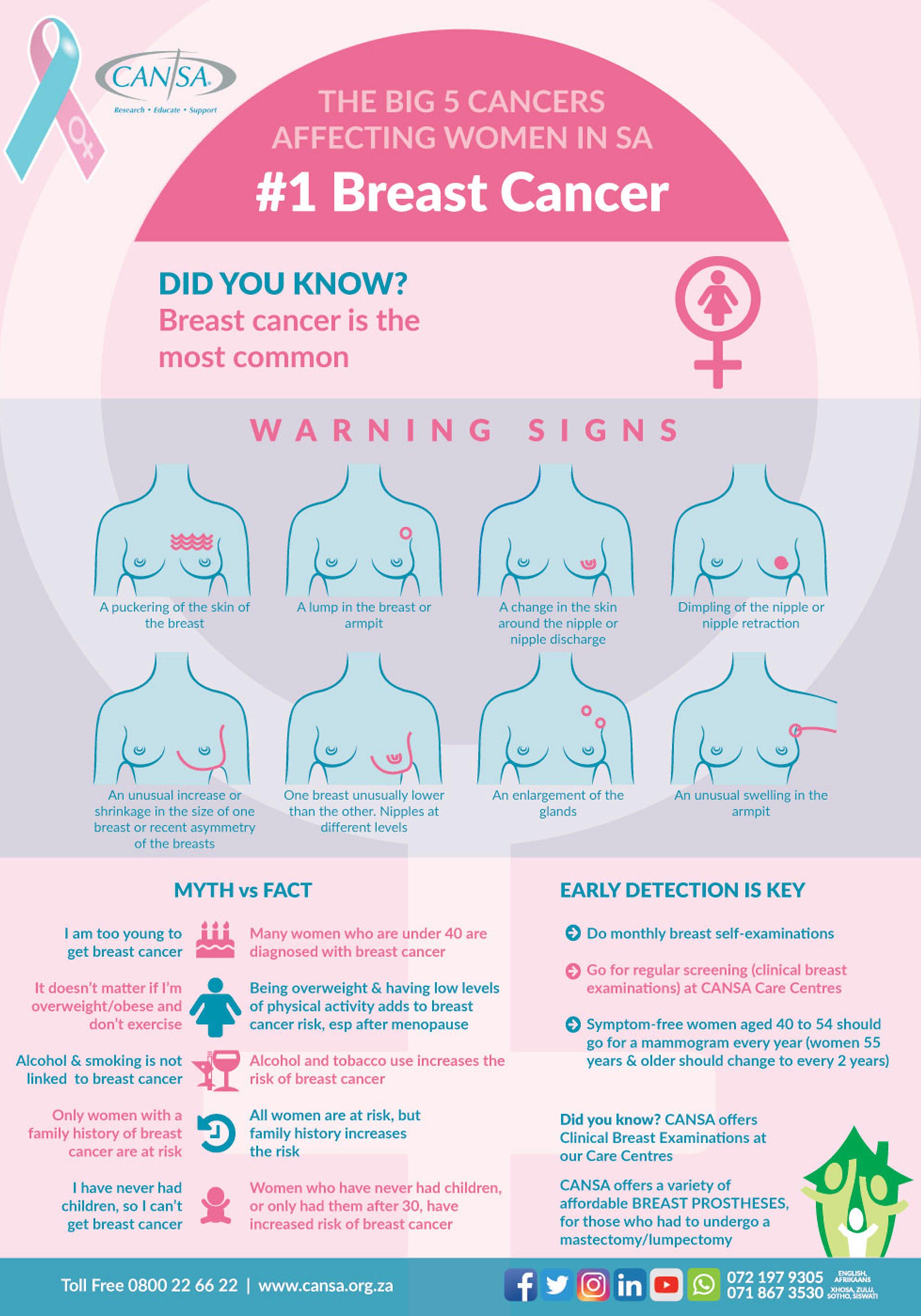
Osteoporosis – a disease which leads to brittle and weak bones – doesn’t just pose a threat to women, but to millions of men as well.
Ahead of World Osteoporosis Day (20 Octo ber), a prevention-minded pharmaceutical company that specialises in men’s and wom en’s health, is increasing awareness of the disease speci cally among men to help reduce fractures in SA’s aging male popula tion.
Nicole Jennings, spokesperson for Pharma Dynamics, says of the country’s 4.3 million men that are over the age of 50, nearly a million are likely to develop osteoporosis. That’s roughly, one in ve men.
“For years, osteoporosis hasn’t been proper ly treated in men, despite a third of all hip fractures worldwide befalling them.
“The high incidence of hip and vertebral fractures in men, as well as the impact it has on their quality of life, highlights that osteo porosis is not only a woman’s disease and that it should be screened for and treated the same as for women.
“It is something which is routinely checked when women reach menopause, since the drop in oestrogen levels results in bone loss. However, all men over the age of 50 should be screened,” she encourages.
According to the International Osteoporosis Foundation, ageing populations and urbani sation are primarily responsible for the rise in osteoporosis cases. Since 1950, ten times the number of older men have developed the disease. By 2050, an estimated 900 million
men are likely to su er from it. Jennings explains there are two types of osteoporosis, namely, “primary osteoporo sis”, which is typically caused by age-related bone loss and “secondary osteoporosis”, which could be related to either vitamin D de ciency, inadequate calcium intake, an overactive thyroid, low levels of testoster one, use of medication that alters bone metabolism, like glucocorticoid medications or hormonal treatments for prostate cancer.
“Unhealthy lifestyle factors also play a role. These include poor diet, alcohol abuse, smoking and not getting enough exercise. A family history, low body mass index (BMI) or smaller bone structure also play a part in osteoporosis risk.”
To limit your risk of osteoporosis, Jen nings recommends the following action:
1. Consume foods that are rich in calcium and vitamin D. If you’re not sure of your dietary intake, ask your doctor or pharma cists about using supplements. Daily sun exposure is another healthy way of getting enough vitamin D.
2. Do 30-40 minutes of weight-bearing exer cises, like weight training, hiking, stair-climb ing, walking, jogging etc at least three to four times a week.

3. Limit alcohol consumption to no more than two units per day.
4. Quit smoking immediately as it increases your risk of a fragility fracture and hip fracture by 29% and 68% respectively.
5. Go for a screening to assess your risk. If you fall into a high-risk category, take your medi cation as prescribed. While osteoporosis
cannot be completely reversed, men (and women) can incorporate healthy habits as part of their daily routine to improve bone health.
Jennings says medications like alendronate, which belongs to a class of non-hormonal medicines known as bisphosphonates can help to rebuild bone and reduce the risk of fractures.
“It’s equally important to avoid activities that involves twisting your spine or bending forward from the waist that could lead to fractures. The risk of falling should also be decreased, especially at home or wherever you spend the most of your time.”
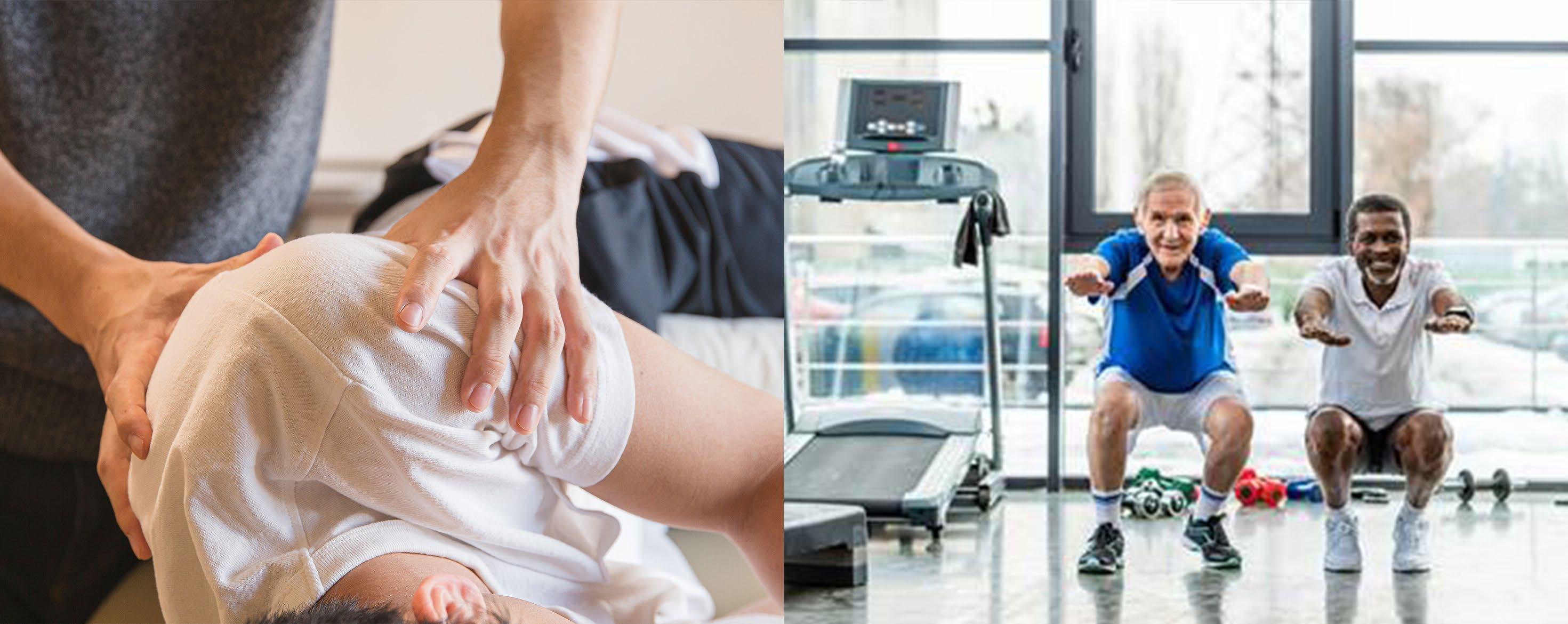
Some of the ways you can make your home safer include:
1. Installing handrails on both sides of the stairs, as well as in bathrooms near the toilet, in the bath and shower.
2. Good lighting is a must at the top and bottom of the stairs, as well as long passage ways.
3. Keeping all walkways tidy and clear of clutter.
4. Installing non-slip tiles and/or xing carpets to the oor.
5. Replacing broken or uneven tiles and paving inside and outside the house.
6. Store frequently used items in an easy to reach place.
For more info on osteoporosis and the treat ment thereof, visit the section on bone and joint health at https://www.mydynamics.co.za/condi tion/bone-and-joint-health/osteoporosis/.